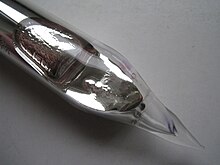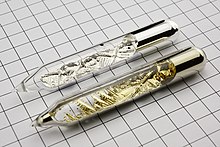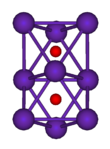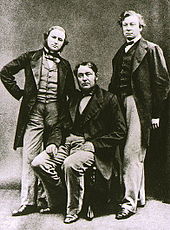Rubidium
 | |||||||||||||||||||||||||||||||||||||||||||||||||||
| Rubidium | |||||||||||||||||||||||||||||||||||||||||||||||||||
|---|---|---|---|---|---|---|---|---|---|---|---|---|---|---|---|---|---|---|---|---|---|---|---|---|---|---|---|---|---|---|---|---|---|---|---|---|---|---|---|---|---|---|---|---|---|---|---|---|---|---|---|
| Pronunciation | /ruːˈbɪdiəm/ | ||||||||||||||||||||||||||||||||||||||||||||||||||
| Appearance | grey white | ||||||||||||||||||||||||||||||||||||||||||||||||||
| Standard atomic weightAr°(Rb) | |||||||||||||||||||||||||||||||||||||||||||||||||||
| Rubidium in theperiodic table | |||||||||||||||||||||||||||||||||||||||||||||||||||
| |||||||||||||||||||||||||||||||||||||||||||||||||||
| Atomic number(Z) | 37 | ||||||||||||||||||||||||||||||||||||||||||||||||||
| Group | group 1: hydrogen andalkali metals | ||||||||||||||||||||||||||||||||||||||||||||||||||
| Period | period 5 | ||||||||||||||||||||||||||||||||||||||||||||||||||
| Block | s-block | ||||||||||||||||||||||||||||||||||||||||||||||||||
| Electron configuration | [Kr] 5s1 | ||||||||||||||||||||||||||||||||||||||||||||||||||
| Electrons per shell | 2, 8, 18, 8, 1 | ||||||||||||||||||||||||||||||||||||||||||||||||||
| Physical properties | |||||||||||||||||||||||||||||||||||||||||||||||||||
| PhaseatSTP | solid | ||||||||||||||||||||||||||||||||||||||||||||||||||
| Melting point | 312.45K(39.30 °C, 102.74 °F) | ||||||||||||||||||||||||||||||||||||||||||||||||||
| Boiling point | 961 K (688 °C, 1270 °F) | ||||||||||||||||||||||||||||||||||||||||||||||||||
| Density(at 20° C) | 1.534 g/cm3[3] | ||||||||||||||||||||||||||||||||||||||||||||||||||
| when liquid (atm.p.) | 1.46 g/cm3 | ||||||||||||||||||||||||||||||||||||||||||||||||||
| Triple point | 312.41 K, ? kPa[4] | ||||||||||||||||||||||||||||||||||||||||||||||||||
| Critical point | 2093 K, 16 MPa(extrapolated)[4] | ||||||||||||||||||||||||||||||||||||||||||||||||||
| Heat of fusion | 2.19kJ/mol | ||||||||||||||||||||||||||||||||||||||||||||||||||
| Heat of vaporization | 69 kJ/mol | ||||||||||||||||||||||||||||||||||||||||||||||||||
| Molar heat capacity | 31.060 J/(mol·K) | ||||||||||||||||||||||||||||||||||||||||||||||||||
Vapor pressure
| |||||||||||||||||||||||||||||||||||||||||||||||||||
| Atomic properties | |||||||||||||||||||||||||||||||||||||||||||||||||||
| Oxidation states | −1,+1(a stronglybasicoxide) | ||||||||||||||||||||||||||||||||||||||||||||||||||
| Electronegativity | Pauling scale: 0.82 | ||||||||||||||||||||||||||||||||||||||||||||||||||
| Ionization energies |
| ||||||||||||||||||||||||||||||||||||||||||||||||||
| Atomic radius | empirical: 248pm | ||||||||||||||||||||||||||||||||||||||||||||||||||
| Covalent radius | 220±9 pm | ||||||||||||||||||||||||||||||||||||||||||||||||||
| Van der Waals radius | 303 pm | ||||||||||||||||||||||||||||||||||||||||||||||||||
| Other properties | |||||||||||||||||||||||||||||||||||||||||||||||||||
| Natural occurrence | primordial | ||||||||||||||||||||||||||||||||||||||||||||||||||
| Crystal structure | body-centered cubic(bcc) (cI2) | ||||||||||||||||||||||||||||||||||||||||||||||||||
| Lattice constant | a= 569.9 pm (at 20 °C)[3] | ||||||||||||||||||||||||||||||||||||||||||||||||||
| Thermal expansion | 85.6×10−6/K (at 20 °C)[3] | ||||||||||||||||||||||||||||||||||||||||||||||||||
| Thermal conductivity | 58.2 W/(m⋅K) | ||||||||||||||||||||||||||||||||||||||||||||||||||
| Electrical resistivity | 128 nΩ⋅m (at 20 °C) | ||||||||||||||||||||||||||||||||||||||||||||||||||
| Magnetic ordering | paramagnetic[5] | ||||||||||||||||||||||||||||||||||||||||||||||||||
| Molar magnetic susceptibility | +17.0×10−6cm3/mol (303 K)[6] | ||||||||||||||||||||||||||||||||||||||||||||||||||
| Young's modulus | 2.4 GPa | ||||||||||||||||||||||||||||||||||||||||||||||||||
| Bulk modulus | 2.5 GPa | ||||||||||||||||||||||||||||||||||||||||||||||||||
| Speed of soundthin rod | 1300 m/s (at 20 °C) | ||||||||||||||||||||||||||||||||||||||||||||||||||
| Mohs hardness | 0.3 | ||||||||||||||||||||||||||||||||||||||||||||||||||
| Brinell hardness | 0.216 MPa | ||||||||||||||||||||||||||||||||||||||||||||||||||
| CAS Number | 7440-17-7 | ||||||||||||||||||||||||||||||||||||||||||||||||||
| History | |||||||||||||||||||||||||||||||||||||||||||||||||||
| Discovery | Robert BunsenandGustav Kirchhoff(1861) | ||||||||||||||||||||||||||||||||||||||||||||||||||
| First isolation | George de Hevesy | ||||||||||||||||||||||||||||||||||||||||||||||||||
| Isotopes of rubidium | |||||||||||||||||||||||||||||||||||||||||||||||||||
| |||||||||||||||||||||||||||||||||||||||||||||||||||
Rubidiumis achemical element;it hassymbolRbandatomic number37. It is a very soft, whitish-grey solid in thealkali metalgroup, similar topotassiumandcaesium.[8]Rubidium is the firstalkali metalin the group to have a density higher thanwater.On Earth, natural rubidium comprises twoisotopes:72% is a stable isotope85Rb, and 28% is slightlyradioactive87Rb, with ahalf-lifeof 48.8 billion years—more than three times as long as the estimatedage of the universe.
German chemistsRobert BunsenandGustav Kirchhoffdiscovered rubidium in 1861 by the newly developed technique,flame spectroscopy.The name comes from theLatinwordrubidus,meaning deep red, the color of its emission spectrum. Rubidium's compounds have various chemical and electronic applications. Rubidium metal is easily vaporized and has a convenient spectral absorption range, making it a frequent target forlasermanipulation ofatoms.[9]Rubidium is not a known nutrient for anyliving organisms.However, rubidiumionshave similar properties and the same charge as potassium ions, and are actively taken up and treated byanimal cellsin similar ways.
Characteristics[edit]

Rubidium is a very soft,ductile,silvery-white metal.[10]It is the second mostelectropositiveof the stable alkali metals and melts at a temperature of 39.3 °C (102.7 °F). Like other alkali metals, rubidium metal reacts violently with water. As with potassium (which is slightly less reactive) and caesium (which is slightly more reactive), this reaction is usually vigorous enough to ignite thehydrogengas it produces. Rubidium has also been reported to ignite spontaneously in air.[10]It formsamalgamswithmercuryandalloyswithgold,iron,caesium,sodium,andpotassium,but notlithium(even though rubidium and lithium are in the same group).[11]

Rubidium has a very lowionization energyof only 406 kJ/mol.[12]Rubidium and potassium show a very similar purple color in theflame test,and distinguishing the two elements requires more sophisticated analysis, such as spectroscopy.[citation needed]
Compounds[edit]

9O
2cluster
Rubidium chloride(RbCl) is probably the most used rubidium compound: among several other chlorides, it is used to induce living cells to take upDNA;it is also used as a biomarker, because in nature, it is found only in small quantities in living organisms and when present, replaces potassium. Other common rubidium compounds are the corrosiverubidium hydroxide(RbOH), the starting material for most rubidium-based chemical processes;rubidium carbonate(Rb2CO3), used in some optical glasses, and rubidium copper sulfate, Rb2SO4·CuSO4·6H2O.Rubidium silver iodide(RbAg4I5) has the highestroom temperatureconductivityof any knownionic crystal,a property exploited in thin filmbatteriesand other applications.[13][14]
Rubidium forms a number ofoxideswhen exposed to air, including rubidium monoxide (Rb2O), Rb6O, and Rb9O2;rubidium in excess oxygen gives thesuperoxideRbO2.Rubidium forms salts with halogens, producingrubidium fluoride,rubidium chloride,rubidium bromide,andrubidium iodide.[15]
Isotopes[edit]
Although rubidium ismonoisotopic,rubidium in the Earth's crust is composed of two isotopes: the stable85Rb (72.2%) and theradioactive87Rb (27.8%).[16]Natural rubidium is radioactive, with specific activity of about 670Bq/g, enough to significantly expose aphotographic filmin 110 days.[17][18]Thirty additional rubidium isotopes have been synthesized with half-lives of less than 3 months; most are highly radioactive and have few uses.[19]
Rubidium-87 has ahalf-lifeof48.8×109years, which is more than three times theage of the universeof(13.799±0.021)×109years,[20]making it aprimordial nuclide.It readily substitutes forpotassiuminminerals,and is therefore fairly widespread. Rb has been used extensively indating rocks;87Rbbeta decaysto stable87Sr. Duringfractional crystallization,Sr tends to concentrate inplagioclase,leaving Rb in the liquid phase. Hence, the Rb/Sr ratio in residualmagmamay increase over time, and the progressingdifferentiationresults in rocks with elevated Rb/Sr ratios. The highest ratios (10 or more) occur inpegmatites.If the initial amount of Sr is known or can be extrapolated, then the age can be determined by measurement of the Rb and Sr concentrations and of the87Sr/86Sr ratio. The dates indicate the true age of the minerals only if the rocks have not been subsequently altered (seerubidium–strontium dating).[21][22]
Rubidium-82,one of the element's non-natural isotopes, is produced byelectron-capturedecay ofstrontium-82with a half-life of 25.36 days. With a half-life of 76 seconds, rubidium-82 decays by positron emission to stablekrypton-82.[16]
Occurrence[edit]
Rubidium is not abundant, being one of 56 elements that combined make up 0.05% of the Earth's crust; at roughly the 23rdmost abundant element in the Earth's crustit is more abundant thanzincorcopper.[23]: 4 It occurs naturally in the mineralsleucite,pollucite,carnallite,andzinnwaldite,which contain as much as 1% rubidiumoxide.Lepidolitecontains between 0.3% and 3.5% rubidium, and is the commercial source of the element.[24]Somepotassiumminerals andpotassium chloridesalso contain the element in commercially significant quantities.[25]
Seawatercontains an average of 125 μg/L of rubidium compared to the much higher value for potassium of 408 mg/L and the much lower value of 0.3 μg/L for caesium.[26]Rubidium is the 18th most abundant element in seawater.[27]
Because of its largeionic radius,rubidium is one of the "incompatible elements".[28]Duringmagma crystallization,rubidium is concentrated together with its heavier analogue caesium in the liquid phase and crystallizes last. Therefore, the largest deposits of rubidium and caesium are zonepegmatiteore bodies formed by this enrichment process. Because rubidium substitutes forpotassiumin the crystallization of magma, the enrichment is far less effective than that of caesium. Zone pegmatite ore bodies containing mineable quantities of caesium aspolluciteor the lithium mineralslepidoliteare also a source for rubidium as a by-product.[23]
Two notable sources of rubidium are the rich deposits ofpolluciteatBernic Lake,Manitoba,Canada, and therubicline((Rb,K)AlSi3O8)found as impurities in pollucite on the Italian island ofElba,with a rubidium content of 17.5%.[29]Both of those deposits are also sources of caesium.[citation needed]
Production[edit]

Although rubidium is more abundant in Earth's crust than caesium, the limited applications and the lack of a mineral rich in rubidium limits the production of rubidium compounds to 2 to 4tonnesper year.[23]Several methods are available for separating potassium, rubidium, and caesium. Thefractional crystallizationof a rubidium and caesium alum(Cs,Rb)Al(SO4)2·12H2Oyields after 30 subsequent steps pure rubidium alum. Two other methods are reported, the chlorostannate process and the ferrocyanide process.[23][30]
For several years in the 1950s and 1960s, a by-product of potassium production called Alkarb was a main source for rubidium. Alkarb contained 21% rubidium, with the rest being potassium and a small amount of caesium.[31]Today the largest producers of caesium produce rubidium as a by-product from pollucite.[23]
History[edit]

Rubidium was discovered in 1861 byRobert BunsenandGustav Kirchhoff,in Heidelberg, Germany, in the minerallepidolitethroughflame spectroscopy.Because of the bright red lines in itsemission spectrum,they chose a name derived from theLatinwordrubidus,meaning "deep red".[32][33]
Rubidium is a minor component inlepidolite.Kirchhoff and Bunsen processed 150 kg of a lepidolite containing only 0.24% rubidium monoxide (Rb2O). Both potassium and rubidium form insoluble salts withchloroplatinic acid,but those salts show a slight difference in solubility in hot water. Therefore, the less soluble rubidiumhexachloroplatinate(Rb2PtCl6) could be obtained byfractional crystallization.After reduction of the hexachloroplatinate withhydrogen,the process yielded 0.51 grams ofrubidium chloride(RbCl) for further studies. Bunsen and Kirchhoff began their first large-scale isolation of caesium and rubidium compounds with 44,000 litres (12,000 US gal) of mineral water, which yielded 7.3 grams ofcaesium chlorideand 9.2 grams ofrubidium chloride.[32][33]Rubidium was the second element, shortly after caesium, to be discovered by spectroscopy, just one year after the invention of thespectroscopeby Bunsen and Kirchhoff.[34]
The two scientists used the rubidium chloride to estimate that theatomic weightof the new element was 85.36 (the currently accepted value is 85.47).[32]They tried to generate elemental rubidium by electrolysis of molten rubidium chloride, but instead of a metal, they obtained a blue homogeneous substance, which "neither under the naked eye nor under the microscope showed the slightest trace of metallic substance". They presumed that it was asubchloride(Rb
2Cl); however, the product was probably acolloidalmixture of the metal and rubidium chloride.[35]In a second attempt to produce metallic rubidium, Bunsen was able to reduce rubidium by heating charred rubidiumtartrate.Although the distilled rubidium waspyrophoric,they were able to determine the density and the melting point. The quality of this research in the 1860s can be appraised by the fact that their determined density differs by less than 0.1 g/cm3and the melting point by less than 1 °C from the presently accepted values.[36]
The slight radioactivity of rubidium was discovered in 1908, but that was before the theory of isotopes was established in 1910, and the low level of activity (half-life greater than 1010years) made interpretation complicated. The now proven decay of87Rb to stable87Sr throughbeta decaywas still under discussion in the late 1940s.[37][38]
Rubidium had minimal industrial value before the 1920s.[39]Since then, the most important use of rubidium is research and development, primarily in chemical and electronic applications. In 1995, rubidium-87 was used to produce aBose–Einstein condensate,[40]for which the discoverers,Eric Allin Cornell,Carl Edwin WiemanandWolfgang Ketterle,won the 2001Nobel Prize in Physics.[41]
Applications[edit]

Rubidium compounds are sometimes used infireworksto give them a purple color.[42]Rubidium has also been considered for use in athermoelectric generatorusing themagnetohydrodynamicprinciple, whereby hot rubidium ions are passed through amagnetic field.[43]These conduct electricity and act like anarmatureof a generator, thereby generating anelectric current.Rubidium, particularly vaporized87Rb, is one of the most commonly used atomic species employed forlaser coolingandBose–Einstein condensation.Its desirable features for this application include the ready availability of inexpensivediode laserlight at the relevantwavelengthand the moderate temperatures required to obtain substantial vapor pressures.[44][45]For cold-atom applications requiring tunable interactions,85Rb is preferred for its richFeshbach spectrum.[46]
Rubidium has been used for polarizing3He,producing volumes of magnetized3He gas, with the nuclear spins aligned rather than random. Rubidium vapor is optically pumped by a laser, and the polarized Rb polarizes3He through thehyperfineinteraction.[47]Suchspin-polarized3He cells are useful for neutron polarization measurements and for producing polarized neutron beams for other purposes.[48]
The resonant element inatomic clocksutilizes thehyperfine structureof rubidium's energy levels, and rubidium is useful for high-precision timing. It is used as the main component of secondary frequency references (rubidium oscillators) in cell site transmitters and other electronic transmitting, networking, and test equipment. Theserubidium standardsare often used withGNSSto produce a "primary frequency standard" that has greater accuracy and is less expensive than caesium standards.[49][50]Such rubidium standards are often mass-produced for thetelecommunicationindustry.[51]
Other potential or current uses of rubidium include a working fluid in vapor turbines, as agetterinvacuum tubes,and as aphotocellcomponent.[52]Rubidium is also used as an ingredient in special types of glass, in the production ofsuperoxideby burning inoxygen,in the study ofpotassiumion channelsin biology, and as the vapor in atomicmagnetometers.[53]In particular,87Rb is used with other alkali metals in the development of spin-exchange relaxation-free(SERF) magnetometers.[53]
Rubidium-82is used forpositron emission tomography.Rubidium is very similar to potassium, and tissue with high potassium content will also accumulate the radioactive rubidium. One of the main uses ismyocardial perfusion imaging.As a result of changes in theblood–brain barrierin brain tumors, rubidium collects more in brain tumors than normal brain tissue, allowing the use of radioisotope rubidium-82 innuclear medicineto locate and image brain tumors.[54]Rubidium-82 has a very short half-life of 76 seconds, and the production from decay ofstrontium-82must be done close to the patient.[55]
Rubidium was tested for the influence on manic depression and depression.[56][57]Dialysis patients suffering from depression show a depletion in rubidium, and therefore a supplementation may help during depression.[58]In some tests the rubidium was administered as rubidium chloride with up to 720 mg per day for 60 days.[59][60]
| Hazards | |
|---|---|
| GHSlabelling: | |
 
| |
| Danger | |
| H260,H314 | |
| P223,P231+P232,P280,P305+P351+P338,P370+P378,P422[61] | |
| NFPA 704(fire diamond) | |
Precautions and biological effects[edit]
Rubidium reacts violently with water and can cause fires. To ensure safety and purity, this metal is usually kept under drymineral oilor sealed in glass ampoules in an inert atmosphere. Rubidium formsperoxideson exposure even to a small amount of air diffused into the oil, and storage is subject to similar precautions as the storage of metallicpotassium.[62]
Rubidium, like sodium and potassium, almost always has +1oxidation statewhen dissolved in water, even in biological contexts. The human body tends to treat Rb+ions as if they were potassium ions, and therefore concentrates rubidium in the body'sintracellular fluid(i.e., inside cells).[63]The ions are not particularly toxic; a 70 kg person contains on average 0.36 g of rubidium, and an increase in this value by 50 to 100 times did not show negative effects in test persons.[64]Thebiological half-lifeof rubidium in humans measures 31–46 days.[56]Although a partial substitution of potassium by rubidium is possible, when more than 50% of the potassium in the muscle tissue of rats was replaced with rubidium, the rats died.[65][66]
References[edit]
- ^"Standard Atomic Weights: Rubidium".CIAAW.1969.
- ^Prohaska, Thomas; Irrgeher, Johanna; Benefield, Jacqueline; Böhlke, John K.; Chesson, Lesley A.; Coplen, Tyler B.; Ding, Tiping; Dunn, Philip J. H.; Gröning, Manfred; Holden, Norman E.; Meijer, Harro A. J. (2022-05-04)."Standard atomic weights of the elements 2021 (IUPAC Technical Report)".Pure and Applied Chemistry.doi:10.1515/pac-2019-0603.ISSN1365-3075.
- ^abcArblaster, John W. (2018).Selected Values of the Crystallographic Properties of Elements.Materials Park, Ohio: ASM International.ISBN978-1-62708-155-9.
- ^abHaynes, William M., ed. (2011).CRC Handbook of Chemistry and Physics(92nd ed.). Boca Raton, FL:CRC Press.p. 4.122.ISBN1-4398-5511-0.
- ^Lide, D. R., ed. (2005). "Magnetic susceptibility of the elements and inorganic compounds".CRC Handbook of Chemistry and Physics(PDF)(86th ed.). Boca Raton (FL): CRC Press.ISBN0-8493-0486-5.
- ^Weast, Robert (1984).CRC, Handbook of Chemistry and Physics.Boca Raton, Florida: Chemical Rubber Company Publishing. pp. E110.ISBN0-8493-0464-4.
- ^Kondev, F. G.; Wang, M.; Huang, W. J.; Naimi, S.; Audi, G. (2021)."The NUBASE2020 evaluation of nuclear properties"(PDF).Chinese Physics C.45(3): 030001.doi:10.1088/1674-1137/abddae.
- ^Lenk, Winfried; Prinz, Horst; Steinmetz, Anja (2010). "Rubidium and Rubidium Compounds".Ullmann's Encyclopedia of Industrial Chemistry.Weinheim: Wiley-VCH.doi:10.1002/14356007.a23_473.pub2.ISBN978-3527306732.
- ^"Rubidium (Rb) | AMERICAN ELEMENTS ®".American Elements: The Materials Science Company.Retrieved2024-03-27.
- ^abOhly, Julius (1910)."Rubidium".Analysis, detection and commercial value of the rare metals.Mining Science Pub. Co.
- ^Holleman, Arnold F.; Wiberg, Egon; Wiberg, Nils (1985). "Vergleichende Übersicht über die Gruppe der Alkalimetalle".Lehrbuch der Anorganischen Chemie(in German) (91–100 ed.). Walter de Gruyter. pp. 953–955.ISBN978-3-11-007511-3.
- ^Moore, John W; Stanitski, Conrad L; Jurs, Peter C (2009).Principles of Chemistry: The Molecular Science.Cengage Learning. p. 259.ISBN978-0-495-39079-4.
- ^Smart, Lesley; Moore, Elaine (1995)."RbAg4I5".Solid state chemistry: an introduction.CRC Press. pp.176–177.ISBN978-0-7487-4068-0.
- ^Bradley, J. N.; Greene, P. D. (1967). "Relationship of structure and ionic mobility in solid MAg4I5".Trans. Faraday Soc.63:2516.doi:10.1039/TF9676302516.
- ^Greenwood, Norman N.;Earnshaw, Alan (1997).Chemistry of the Elements(2nd ed.).Butterworth-Heinemann.ISBN978-0-08-037941-8.
- ^abAudi, Georges; Bersillon, Olivier; Blachot, Jean;Wapstra, Aaldert Hendrik(2003),"The NUBASEevaluation of nuclear and decay properties ",Nuclear Physics A,729:3–128,Bibcode:2003NuPhA.729....3A,doi:10.1016/j.nuclphysa.2003.11.001
- ^Strong, W. W. (1909)."On the Possible Radioactivity of Erbium, Potassium and Rubidium".Physical Review.Series I.29(2): 170–173.Bibcode:1909PhRvI..29..170S.doi:10.1103/PhysRevSeriesI.29.170.
- ^Lide, David R; Frederikse, H. P. R (June 1995).CRC handbook of chemistry and physics: a ready-reference book of chemical and physical data.CRC-Press. pp. 4–25.ISBN978-0-8493-0476-7.
- ^"Universal Nuclide Chart".nucleonica.Archivedfrom the original on 2017-02-19.Retrieved2017-01-03.
- ^Planck Collaboration (2016). "Planck 2015 results. XIII. Cosmological parameters (See Table 4 on page 31 of pfd)".Astronomy & Astrophysics.594:A13.arXiv:1502.01589.Bibcode:2016A&A...594A..13P.doi:10.1051/0004-6361/201525830.S2CID119262962.
- ^Attendorn, H.-G.; Bowen, Robert (1988)."Rubidium-Strontium Dating".Isotopes in the Earth Sciences.Springer. pp. 162–165.ISBN978-0-412-53710-3.
- ^Walther, John Victor (2009) [1988]."Rubidium-Strontium Systematics".Essentials of geochemistry.Jones & Bartlett Learning. pp. 383–385.ISBN978-0-7637-5922-3.
- ^abcdeButterman, William C.; Brooks, William E.; Reese, Robert G. Jr. (2003)."Mineral Commodity Profile: Rubidium"(PDF).United States Geological Survey.Retrieved2010-12-04.
- ^Wise, M. A. (1995). "Trace element chemistry of lithium-rich micas from rare-element granitic pegmatites".Mineralogy and Petrology.55(13): 203–215.Bibcode:1995MinPe..55..203W.doi:10.1007/BF01162588.S2CID140585007.
- ^Norton, J. J. (1973)."Lithium, cesium, and rubidium—The rare alkali metals".In Brobst, D. A.; Pratt, W. P. (eds.).United States mineral resources.Vol. Paper 820. U.S. Geological Survey Professional. pp. 365–378. Archived fromthe originalon 2010-07-21.Retrieved2010-09-26.
- ^Bolter, E.; Turekian, K.; Schutz, D. (1964). "The distribution of rubidium, cesium and barium in the oceans".Geochimica et Cosmochimica Acta.28(9): 1459.Bibcode:1964GeCoA..28.1459B.doi:10.1016/0016-7037(64)90161-9.
- ^William A. Hart |title=The Chemistry of Lithium, Sodium, Potassium, Rubidium, Caesium, and Francium |page=371
- ^McSween Jr., Harry Y; Huss, Gary R (2010).Cosmochemistry.Cambridge University Press. p. 224.ISBN978-0-521-87862-3.
- ^Teertstra, David K.;Cerny, Petr;Hawthorne, Frank C.; Pier, Julie; Wang, Lu-Min; Ewing, Rodney C. (1998). "Rubicline, a new feldspar from San Piero in Campo, Elba, Italy".American Mineralogist.83(11–12 Part 1): 1335–1339.Bibcode:1998AmMin..83.1335T.doi:10.2138/am-1998-11-1223.
- ^bulletin 585.United States. Bureau of Mines. 1995.
- ^"Cesium and Rubidium Hit Market".Chemical & Engineering News.37(22): 50–56. 1959.doi:10.1021/cen-v037n022.p050.
- ^abcKirchhoff, G.;Bunsen, R.(1861)."Chemische Analyse durch Spectralbeobachtungen"(PDF).Annalen der Physik und Chemie.189(7): 337–381.Bibcode:1861AnP...189..337K.doi:10.1002/andp.18611890702.hdl:2027/hvd.32044080591324.
- ^abWeeks, Mary Elvira(1932). "The discovery of the elements. XIII. Some spectroscopic discoveries".Journal of Chemical Education.9(8): 1413–1434.Bibcode:1932JChEd...9.1413W.doi:10.1021/ed009p1413.
- ^Ritter, Stephen K. (2003)."C&EN: It's Elemental: The Periodic Table – Cesium".American Chemical Society.Retrieved2010-02-25.
- ^Zsigmondy, Richard (2007).Colloids and the Ultra Microscope.Read books. p. 69.ISBN978-1-4067-5938-9.Retrieved2010-09-26.
- ^Bunsen, R. (1863)."Ueber die Darstellung und die Eigenschaften des Rubidiums".Annalen der Chemie und Pharmacie.125(3): 367–368.doi:10.1002/jlac.18631250314.
- ^Lewis, G. M. (1952). "The natural radioactivity of rubidium".Philosophical Magazine.Series 7.43(345): 1070–1074.doi:10.1080/14786441008520248.
- ^Campbell, N. R.; Wood, A. (1908)."The Radioactivity of Rubidium".Proceedings of the Cambridge Philosophical Society.14:15.
- ^Butterman, W. C.; Reese, R. G. Jr."Mineral Commodity Profiles Rubidium"(PDF).United States Geological Survey.Retrieved2010-10-13.
- ^"Press Release: The 2001 Nobel Prize in Physics".Retrieved2010-02-01.
- ^Levi, Barbara Goss(2001)."Cornell, Ketterle, and Wieman Share Nobel Prize for Bose-Einstein Condensates".Physics Today.54(12): 14–16.Bibcode:2001PhT....54l..14L.doi:10.1063/1.1445529.
- ^Koch, E.-C. (2002)."Special Materials in Pyrotechnics, Part II: Application of Caesium and Rubidium Compounds in Pyrotechnics".Journal Pyrotechnics.15:9–24. Archived fromthe originalon 2011-07-13.Retrieved2010-01-29.
- ^Boikess, Robert S; Edelson, Edward (1981).Chemical principles.Harper & Row. p. 193.ISBN978-0-06-040808-4.
- ^Eric Cornell; et al. (1996)."Bose-Einstein condensation (all 20 articles)".Journal of Research of the National Institute of Standards and Technology.101(4): 419–618.doi:10.6028/jres.101.045.PMC4907621.PMID27805098.Archived fromthe originalon 2011-10-14.Retrieved2015-09-14.
- ^Martin, J. L.; McKenzie, C. R.; Thomas, N. R.; Sharpe, J. C.; Warrington, D. M.; Manson, P. J.; Sandle, W. J.; Wilson, A. C. (1999). "Output coupling of a Bose-Einstein condensate formed in a TOP trap".Journal of Physics B: Atomic, Molecular and Optical Physics.32(12): 3065.arXiv:cond-mat/9904007.Bibcode:1999JPhB...32.3065M.doi:10.1088/0953-4075/32/12/322.S2CID119359668.
- ^Chin, Cheng; Grimm, Rudolf; Julienne, Paul; Tiesinga, Eite (2010-04-29). "Feshbach resonances in ultracold gases".Reviews of Modern Physics.82(2): 1225–1286.arXiv:0812.1496.Bibcode:2010RvMP...82.1225C.doi:10.1103/RevModPhys.82.1225.S2CID118340314.
- ^Gentile, T. R.; Chen, W. C.; Jones, G. L.; Babcock, E.; Walker, T. G. (2005)."Polarized3He spin filters for slow neutron physics "(PDF).Journal of Research of the National Institute of Standards and Technology.110(3): 299–304.doi:10.6028/jres.110.043.PMC4849589.PMID27308140.Archived fromthe original(PDF)on 2016-12-21.Retrieved2015-08-06.
- ^"Neutron spin filters based on polarized helium-3".NIST Center for Neutron Research 2002 Annual Report.Retrieved2008-01-11.
- ^Eidson, John C (2006-04-11)."GPS".Measurement, control, and communication using IEEE 1588.Springer. p. 32.ISBN978-1-84628-250-8.
- ^King, Tim; Newson, Dave (1999-07-31)."Rubidium and crystal oscillators".Data network engineering.Springer. p. 300.ISBN978-0-7923-8594-3.
- ^Marton, L. (1977-01-01)."Rubidium Vapor Cell".Advances in electronics and electron physics.Academic Press.ISBN978-0-12-014644-4.
- ^Mittal (2009).Introduction To Nuclear And Particle Physics.Prentice-Hall Of India Pvt. Limited. p. 274.ISBN978-81-203-3610-0.
- ^abLi, Zhimin; Wakai, Ronald T.; Walker, Thad G. (2006)."Parametric modulation of an atomic magnetometer".Applied Physics Letters.89(13): 23575531–23575533.Bibcode:2006ApPhL..89m4105L.doi:10.1063/1.2357553.PMC3431608.PMID22942436.
- ^Yen, C. K.; Yano, Y.; Budinger, T. F.; Friedland, R. P.; Derenzo, S. E.; Huesman, R. H.; O'Brien, H. A. (1982). "Brain tumor evaluation using Rb-82 and positron emission tomography".Journal of Nuclear Medicine.23(6): 532–7.PMID6281406.
- ^Jadvar, H.; Anthony Parker, J. (2005)."Rubidium-82".Clinical PET and PET/CT.Springer. p. 59.ISBN978-1-85233-838-1.
- ^abPaschalis, C.; Jenner, F. A.; Lee, C. R. (1978)."Effects of rubidium chloride on the course of manic-depressive illness".J R Soc Med.71(9): 343–352.doi:10.1177/014107687807100507.PMC1436619.PMID349155.
- ^Malekahmadi, P.; Williams, John A. (1984). "Rubidium in psychiatry: Research implications".Pharmacology Biochemistry and Behavior.21:49–50.doi:10.1016/0091-3057(84)90162-X.PMID6522433.S2CID2907703.
- ^Canavese, Caterina; Decostanzi, Ester; Branciforte, Lino; Caropreso, Antonio; Nonnato, Antonello; Sabbioni, Enrico (2001)."Depression in dialysis patients: Rubidium supplementation before other drugs and encouragement?".Kidney International.60(3): 1201–2.doi:10.1046/j.1523-1755.2001.0600031201.x.PMID11532118.
- ^Lake, James A. (2006).Textbook of Integrative Mental Health Care.New York: Thieme Medical Publishers. pp. 164–165.ISBN978-1-58890-299-3.
- ^Torta, R.; Ala, G.; Borio, R.; Cicolin, A.; Costamagna, S.; Fiori, L.; Ravizza, L. (1993). "Rubidium chloride in the treatment of major depression".Minerva Psichiatrica.34(2): 101–110.PMID8412574.
- ^"Rubidium 276332".Sigma-Aldrich.
- ^Martel, Bernard; Cassidy, Keith (2004-07-01)."Rubidium".Chemical risk analysis: a practical handbook.Butterworth-Heinemann. p. 215.ISBN978-1-903996-65-2.
- ^Relman, A. S. (1956)."The Physiological Behavior of Rubidium and Cesium in Relation to That of Potassium".The Yale Journal of Biology and Medicine.29(3): 248–62.PMC2603856.PMID13409924.
- ^Fieve, Ronald R.; Meltzer, Herbert L.; Taylor, Reginald M. (1971). "Rubidium chloride ingestion by volunteer subjects: Initial experience".Psychopharmacologia.20(4): 307–14.doi:10.1007/BF00403562.PMID5561654.S2CID33738527.
- ^Meltzer, H. L. (1991)."A pharmacokinetic analysis of long-term administration of rubidium chloride".Journal of Clinical Pharmacology.31(2): 179–84.doi:10.1002/j.1552-4604.1991.tb03704.x.PMID2010564.S2CID2574742.Archived fromthe originalon 2012-07-09.
- ^Follis, Richard H. Jr. (1943)."Histological effects in rats resulting from adding rubidium or cesium to a diet deficient in potassium".AJP: Legacy Content.138(2): 246–250.doi:10.1152/ajplegacy.1943.138.2.246.
Further reading[edit]
- Meites, Louis (1963).Handbook of Analytical Chemistry(New York: McGraw-Hill Book Company, 1963)
- Steck, Daniel A."Rubidium-87 D Line Data"(PDF).Los Alamos National Laboratory (technical report LA-UR-03-8638). Archived fromthe original(PDF)on 2013-11-02.Retrieved2008-02-09.
External links[edit]
- .Encyclopædia Britannica.Vol. 23 (11th ed.). 1911. p. 809.
- RubidiumatThe Periodic Table of Videos(University of Nottingham)



